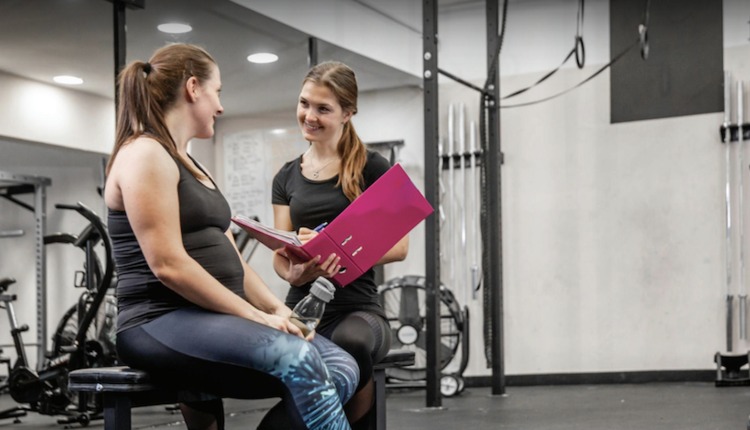Metabolism is almost a mythical word. Everyone talks about it, yet few really know what it is. In fact, it's not uncommon to hear clients say things like, "My metabolism is slow," "I shut down my metabolism from dieting too much" or "there's no hope for me; I have no metabolism." Have you ever asked a client if they know what metabolism actually means? In fact, do YOU even know what it means?
[Metabolism: The biochemical reactions that occur within a living organism and the energy exchanges and transformations that accompany them.]
Now you do. Or do you? When clients say things like they have no metabolism, they're actually referring to their metabolic rate. By saying they have no metabolism, it essentially means that they have no ability to utilize food for energy. Huh? Doesn't make sense, does it? It shouldn't. Let's solve this metabolism puzzle and see what we can do to keep that metabolic rate revving (and let's get rid of myth #1: yo-yo dieting won't "mess it up," and overweight or obese people almost always have high metabolic rates because of their larger body mass).
When we talk about metabolic rate, we have to discuss energy expenditure (EE). So basically, how many calories do we need on a daily basis? EE, calories expended, is actually comprised of a number of factors:
- Resting Metabolic Rate: RMR is the largest component of energy expenditure and is defined as the calories necessary for the maintenance of normal body functions in resting conditions. Basically, this is the amount of energy needed just to sustain life, therefore, energy used for basic life functions: maintaining a heart beat, breathing and immune function. RMR comprises approximately 60% to 75% of overall energy expenditure. However, this value changes with body weight and is primarily related to fat-free mass (muscle mass) but is also affected by age, gender, body composition and various genetic factors.Additionally, RMR decreases with age, seemingly decreasing with each decade by two to three percent. However, this decrease can be blunted by regular resistance training and maintenance of lean body mass. So the more overall body mass one has, the higher his or her RMR will be. Males also typically have a higher RMR than females.
- Thermic Effect of Food (TEF) or Diet-Induced Thermogenesis (DIT): TEF and DIT are used interchangeably, but for this article, TEF will be referenced primarily. TEF comprises about 10% of overall energy balance and is defined as the increase in energy expenditure above RMR, which occurs after a meal due to normal digestion, metabolism and absorption. The contribution of TEF to energy balance is dependent on a number of factors, including the overall energy content of the meal (e.g., an apple vs. Thanksgiving dinner) and the composition of the meal. In fact, carbohydrates, proteins and fats all have different effects on TEF.
- Exercise: This is, in fact, the component individuals have the most control over, and it is the most variable component of energy expenditure, accounting for anywhere from an average of 30% of daily expenditure all the way up to 80% in extreme athletes or conditions (e.g., Tour de France cyclists). Exercise is a voluntary contribution to energy expenditure, while factors like shivering, fidgeting and postural changes are involuntary contributions. Research actually suggests these involuntary changes may contribute to weight loss.
Now that we have that squared away, let's see how we can tinker with each of these factors to make sure your clients optimize their metabolic rate to help with weight management — remember, every year people age can, unfortunately, slow things down a bit.
- Move often. Not your residence, I mean your body. Unfortunately, our clients often exercise for 30 to 60 minutes each day and then do nothing but sit on their backsides for the remainder of their waking hours. This is not conducive to calorie expenditure. So move, and move often. If clients have a rather sedentary job, teach them how to get up and do some stretching; maybe walk around a bit or some other movement every 30 minutes or so. It will not only improve their health, but it will improve their mental functions too.
- Resistance train. Not rocket science, but building lean muscle will help to slow the metabolic rate that's normal with aging. Of course, resistance training has a ton of other benefits as well — this is just one of the many! So when clients lift weights, have them lift the heaviest weights possible with perfect form. Many people shy away from heavier weights because they're afraid of "bulking," which is a whole other myth that could take the entire magazine to demystify! Make sure to tell your clients that doing a squat won't make them resemble the Incredible Hulk (sans the green skin).
- Add intervals. Data is continuing to mount showing that high-intensity interval training (sprints, hill runs, etc.) will give a metabolic boost above and beyond simple cardio
exercise. With that said, keep your clientele in mind; not everyone is an appropriate candidate for interval training. Be conscious of who you're working with, and treat each person individually. - Include some protein with each meal. I'm not saying to rely solely on protein; but what I am saying is that since metabolizing protein is a little more "difficult" for the body, increasing the calories burned by including some protein with each meal could have some benefit. Of course, we still need to couple this with loads of fruits and veggies, some whole grains and healthy fats.
- Drink tea. Maybe, just maybe, this may help increase your clients' metabolic rates. Is it the cure-all for the obesity epidemic? Well, that's taking things a bit too far, but some data does suggest that regular tea consumption may help with losing body weight, potentially
because of an increase in metabolic rate. And notice I said drink tea, so don't supplement with "tea pills." The wonderful thing about tea is that even if none of these weight loss benefits ever pan out, we know for sure that it is a powerful source of antioxidants, may decrease the risk of heart disease and potentially could even help prevent other diseases as well. Moral of the story? There's certainly no harm in drinking several cups per day (but there may be in not drinking any!). - Add herbs and spices to foods. Yup, you heard it here first. Herbs and spices may also boost metabolic rate. Spices, like chili pepper and cayenne powder, have been shown to potentially boost metabolic rate (just think how you sweat when you eat them). And more importantly, like tea, there's certainly no harm in including them, yet there are loads of other benefits, including being a very concentrated source of free, radical-fighting antioxidants, but not any calories or fat, so have your clients eat up!
- Try… fish oil? More breaking news: add one more checkmark in the "benefits of fish oil" column. A recent study published in the American Journal of Clinical Nutrition suggested that those using a fish oil supplement (with exercise) had great body composition changes than the exercise-only group. The mechanism is not exactly understood, but it proposes that fish oil could change heart rate variability and mobilize fats to be used as fuel or something else along these lines. If it does, in fact, lower heart rate (unpublished data at the time of writing), this could be how it boosts metabolic rate — clients would have to work harder for the same benefit as someone with a higher heart rate to begin with. Things that make you go, "Hmmm." A personal favorite of mine for fish oil supplements is Ultimate Omega by Nordic Naturals — yet one more product where even if it doesn't pan out for weight loss or increasing metabolic rate, Omega-3 fats have been shown to have other benefits as well.
So there you have it: quick tips your clients can implement today to start making a change! Don't let the metabolism mystery fool them anymore. When clients tell me they have no metabolism, I often check for a pulse — because that would mean they are no longer living. As fitness professionals, you can now tell them the truth!
Dr. Christopher Mohr, RD, is the co-owner of Mohr Results, Inc. He is often sought out by the media as a nutrition expert. For more information, visit www.MohrResults.com or email him at Chris@MohrResults.com. l











